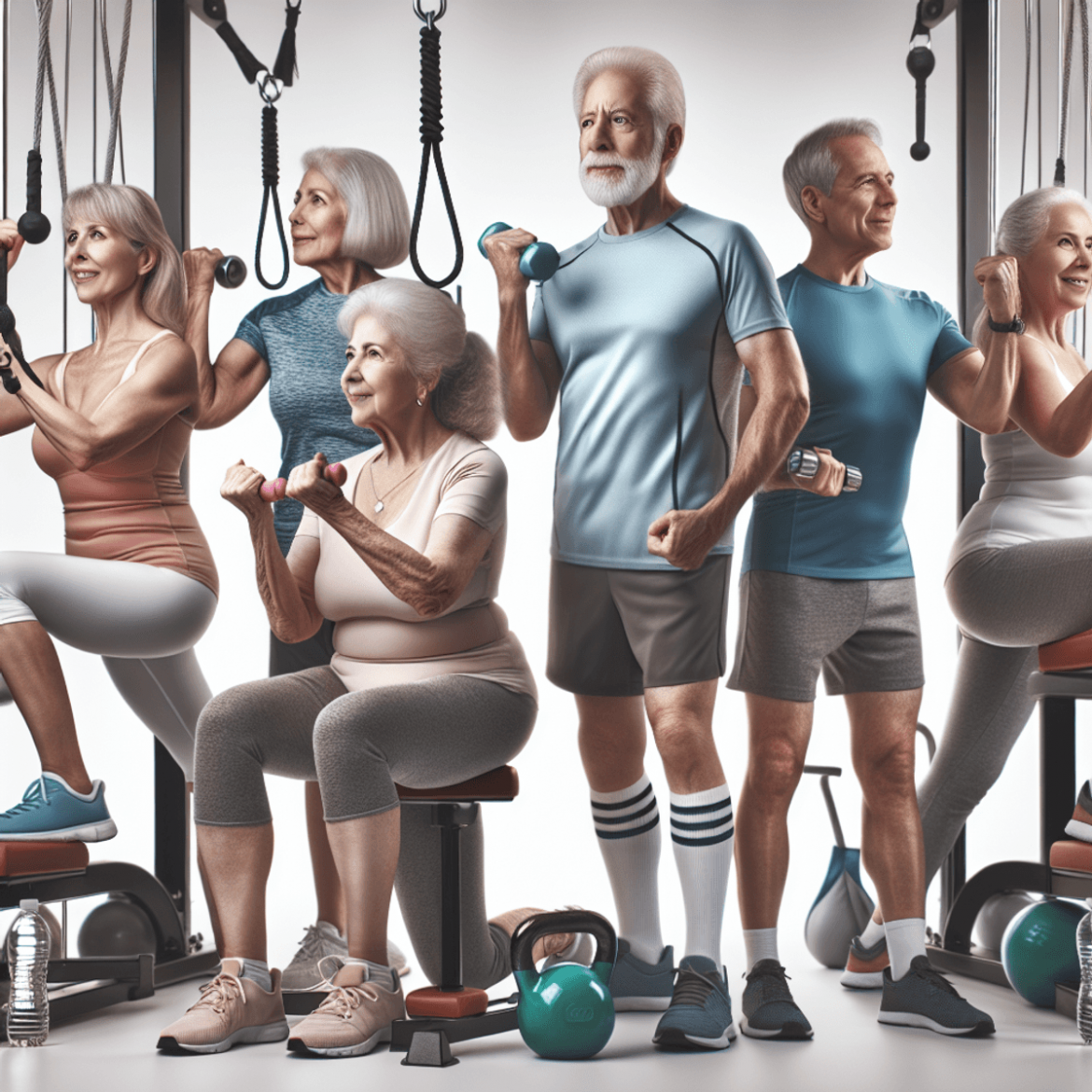Introduction
Aging gracefully involves more than just maintaining a youthful appearance; it is also about preserving muscle mass and overall health. As we age, the natural process of muscle loss, known as sarcopenia, can begin as early as 30-35 years old. This decline in muscle mass can lead to increased risks of falls, fractures, and other health complications.
Key takeaway: Adequate protein intake is crucial for maintaining muscle mass as we age.
In this article, you will learn about:
- The silent thief of muscle mass: Sarcopenia
- The pivotal role of protein in muscle maintenance
- How strength training can be a powerful ally against sarcopenia
- Debunking common protein myths for older adults
- Practical tips for boosting your protein intake as you age gracefully
Understanding Sarcopenia: The Silent Thief of Muscle Mass
Sarcopenia is a condition characterized by the loss of muscle mass and strength. It is often referred to as the “silent thief” because it gradually diminishes muscle tissue without obvious symptoms until significant deterioration occurs. This muscle loss typically begins around the age of 30-35 and accelerates with each passing decade.
Definition and Causes of Sarcopenia
Sarcopenia stems from a combination of factors:
- Aging: Natural decline in muscle fibers and protein synthesis.
- Physical Inactivity: Reduced engagement in strength-building activities.
- Nutritional Deficiencies: Inadequate protein intake crucial for muscle maintenance.
- Hormonal Changes: Decreased levels of growth hormone and testosterone.
Age and Onset of Muscle Loss
Muscle mass reduction can start as early as your 30s. Without intervention, you may experience up to a 3-5% loss per decade after age 30. By the time you reach your 60s and beyond, this rate can increase significantly, impacting overall health and functionality.
Consequences on Health and Functional Independence
The impact of sarcopenia extends beyond mere muscle loss:
- Increased Risk of Falls and Fractures: Weakened muscles lead to instability.
- Reduced Metabolic Rate: Less muscle mass means fewer calories burned at rest.
- Impaired Daily Activities: Difficulty performing tasks like climbing stairs or lifting objects.
- Chronic Conditions: Higher susceptibility to diseases such as osteoporosis and diabetes.
Understanding sarcopenia underscores the importance of proactive measures such as adequate protein intake and regular physical activity to mitigate its effects.
The Role of Protein in Muscle Maintenance
Dietary protein is essential for muscle repair and growth. As we age, our bodies become less efficient at utilizing protein, making adequate intake crucial for maintaining muscle mass. For older adults, the recommended daily intake is approximately 1.0 to 1.3 grams per kilogram of body weight.
Essential Amino Acids and Their Sources
Proteins are composed of amino acids, which are the building blocks of muscle tissue. Of these, nine are classified as essential amino acids (EAAs) because they cannot be synthesized by the body and must be obtained from dietary sources.
- Leucine: Found in high amounts in animal products like beef and dairy.
- Isoleucine: Present in eggs, fish, and poultry.
- Valine: Abundant in soy products and legumes.
Animal-Based vs. Plant-Based Proteins: Which Is Better for Aging Muscles?
Benefits of Animal-Based Proteins
Animal-based proteins are often considered superior for muscle synthesis due to their complete amino acid profiles:
- High Biological Value (HBV): Animal proteins such as whey, beef, and eggs have an HBV, meaning they contain all essential amino acids in optimal ratios.
- Rich in Leucine: Leucine is particularly effective at stimulating muscle protein synthesis (MPS), making animal proteins more efficient for muscle repair and growth.
Comparison with Plant-Based Proteins
Plant-based proteins, while beneficial, typically lack one or more essential amino acids:
- Incomplete Amino Acid Profiles: Many plant proteins do not offer all EAAs in sufficient quantities.
- Lower Digestibility: Plant proteins often have lower digestibility compared to animal proteins.
However, combining different plant sources can create a complete amino acid profile:
Pairing rice and beans or hummus and whole grain pita ensures you get all essential amino acids.
Strategies for Incorporating Both Types into Your Diet
Balancing both animal-based and plant-based proteins can optimize your dietary intake:
- Breakfast: Include Greek yogurt or scrambled eggs with avocado on whole-grain toast.
- Lunch: Opt for a quinoa salad with mixed vegetables and a side of grilled chicken.
- Dinner: Enjoy a balanced meal of salmon with steamed broccoli and lentils.
For vegetarians or those reducing meat consumption:
- Use soy products like tofu or tempeh to meet protein needs.
- Incorporate legumes such as chickpeas and lentils into daily meals.
Ensuring diverse sources of protein helps cover all essential amino acids effectively while catering to personal dietary preferences.
Strength Training: A Powerful Ally Against Sarcopenia
Overview of Strength Training Benefits for Older Adults
Strength training, also known as resistance training, is crucial for maintaining muscle mass and overall health in older adults. Engaging in regular strength training can:
- Enhance muscle strength and endurance
- Improve bone density, reducing the risk of osteoporosis
- Increase metabolic rate, aiding in weight management
- Boost functional independence, making daily activities easier
- Enhance mental health, providing a sense of well-being and reducing symptoms of depression
Progressive Resistance Training (PRT) and Its Effectiveness in Combating Sarcopenia
Progressive resistance training (PRT) is a specific type of strength training that involves gradually increasing the amount of resistance used during exercises. This method is highly effective in combating sarcopenia by:
- Stimulating muscle growth through continuous adaptation to increased loads
- Enhancing neuromuscular coordination, improving balance and reducing fall risk
- Promoting muscle protein synthesis, crucial for muscle repair and growth
Studies show that older adults who engage in PRT experience significant gains in muscle mass and strength, making it an essential component of any exercise regimen focused on aging gracefully.
Combining Protein Intake with Exercise: The Perfect Recipe for Muscle Preservation
Timing Protein Intake Around Workouts for Optimal Results
To maximize the benefits of strength training, it’s important to time your protein intake effectively. Consuming protein-rich meals or snacks within 30 minutes to 2 hours post-exercise can:
- Enhance muscle recovery by providing the necessary amino acids for repair
- Promote muscle protein synthesis, leading to greater muscle gains
- Reduce muscle soreness and fatigue, facilitating quicker recovery times
How High-Protein Diets Enhance Recovery Post-Exercise
A high-protein diet supports exercise recovery and boosts muscle power by:
- Providing essential amino acids needed for muscle repair and growth
- Supporting immune function, which can be compromised by intense exercise
- Maintaining lean body mass, crucial for overall metabolic health
Incorporating a balanced diet rich in high-quality proteins alongside regular strength training forms a powerful strategy against sarcopenia. Animal-based proteins like lean meats, dairy, and eggs are particularly effective due to their complete amino acid profiles. However, plant-based sources such as beans, lentils, and tofu can also contribute significantly when combined properly.
By focusing on these strategies, you can enhance your ability to maintain and build muscle mass as you age, ensuring a more active and independent lifestyle.
Debunking Protein Myths: What Older Adults Really Need to Know
Misconceptions about dietary allowances (RDA) for protein often lead to confusion, especially among older adults. The RDA for protein is set at 0.8 grams per kilogram of body weight per day. However, this recommendation is a general guideline and may not meet the needs of older adults or those who are physically active.
Key Points to Consider:
- Higher Needs for Older Adults: Research indicates that older adults require approximately 1.0 to 1.3 grams of protein per kilogram of body weight daily to support muscle maintenance and repair.
- Active Lifestyles: For those who engage in regular physical activity or strength training, protein needs can be even higher—up to 1.5 grams per kilogram of body weight.
- Energy Deficit Phases: During periods of energy deficit, such as weight loss phases, maintaining a higher protein intake is critical to preserve lean muscle mass.
Debunking Common Myths:
- Myth: The RDA is sufficient for everyone.
- Reality: Aging individuals and active adults often need more than the standard RDA to maintain muscle health.
- Myth: Plant-based proteins are inferior.
- Reality: While animal-based proteins provide essential amino acids efficiently, combining various plant-based proteins can also meet your needs.
- Myth: High-protein diets are harmful.
- Reality: When balanced with other nutrients, high-protein diets can enhance muscle synthesis and overall health without adverse effects.
Understanding these nuances ensures you make informed dietary choices that support muscle health as you age gracefully.
Practical Tips for Boosting Your Protein Intake as You Age Gracefully!
Easy Ways to Incorporate More Protein into Meals and Snacks Throughout the Day
Maintaining an adequate protein intake doesn’t have to be complicated. Here are some dietary strategies to help you seamlessly increase your protein consumption:
1. Start Your Day with Protein
Incorporate high-quality proteins like eggs, Greek yogurt, or cottage cheese into your breakfast. These options are rich in essential amino acids and can help kickstart muscle synthesis.
2. Protein-Packed Snacks
Keep protein-rich snacks handy. Nuts, seeds, cheese sticks, and boiled eggs are convenient options that provide a quick protein boost between meals.
3. Enrich Main Meals
Add lean meats, fish, or plant-based proteins like tofu and legumes to your lunch and dinner. A balanced meal should include a substantial protein source alongside vegetables and whole grains.
4. Smoothies and Shakes
Blend a protein shake or smoothie using whey protein powder or plant-based alternatives. Add fruits, vegetables, and a liquid base like almond milk for a nutritious snack or meal replacement.
5. Incorporate Dairy
Include dairy products such as milk, cheese, or yogurt in your diet. They are excellent sources of high-quality protein and also provide calcium for bone health.
6. Beans and Legumes
Integrate beans, lentils, and chickpeas into soups, salads, and stews. These plant-based proteins are versatile and can be easily added to various dishes.
Meal Planning for Success
Effective meal planning can significantly aid in ensuring you meet your daily protein requirements:
- Plan Ahead: Prepare a weekly meal plan that includes high-protein foods in every meal. This helps avoid last-minute food choices that may lack sufficient protein.
- Batch Cooking: Cook large portions of protein-rich meals and store them in the fridge or freezer. This saves time during busy days and ensures you always have a nutritious option available.
- Protein-Rich Recipes: Explore new recipes that focus on high-protein ingredients. Websites and cookbooks dedicated to healthy aging often feature meals designed to enhance muscle maintenance.
By incorporating these simple yet effective strategies into your daily routine, you can ensure you’re getting enough high-quality proteins to support muscle health as you age gracefully.
Conclusion
Aging gracefully requires a proactive approach to maintaining muscle mass. Adequate protein intake plays a crucial role in this process, ensuring that your muscles have the necessary building blocks for repair and growth. Integrating strength training into your routine further enhances muscle preservation, combating the effects of sarcopenia.
Key strategies for healthy aging include:
- Consuming sufficient protein: Aim for 1.0 to 1.3 grams per kilogram of body weight daily.
- Balancing animal and plant-based proteins: Utilize diverse protein sources to maximize nutrient intake.
- Incorporating regular strength training: Engage in progressive resistance training (PRT) to build and maintain muscle mass.
Adopting these practices can significantly improve your quality of life and promote healthy aging. Making informed dietary choices and committing to regular exercise routines are essential steps towards achieving this goal.
“Aging Gracefully: The Importance of Protein in Maintaining Muscle Mass” emphasizes that maintaining muscle mass is not just about physical strength but also about enhancing overall well-being and independence as you age.”



